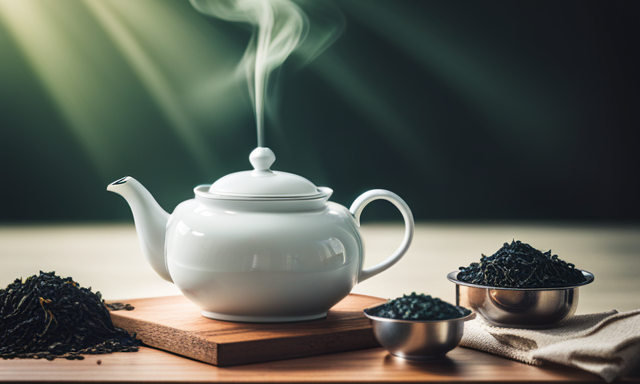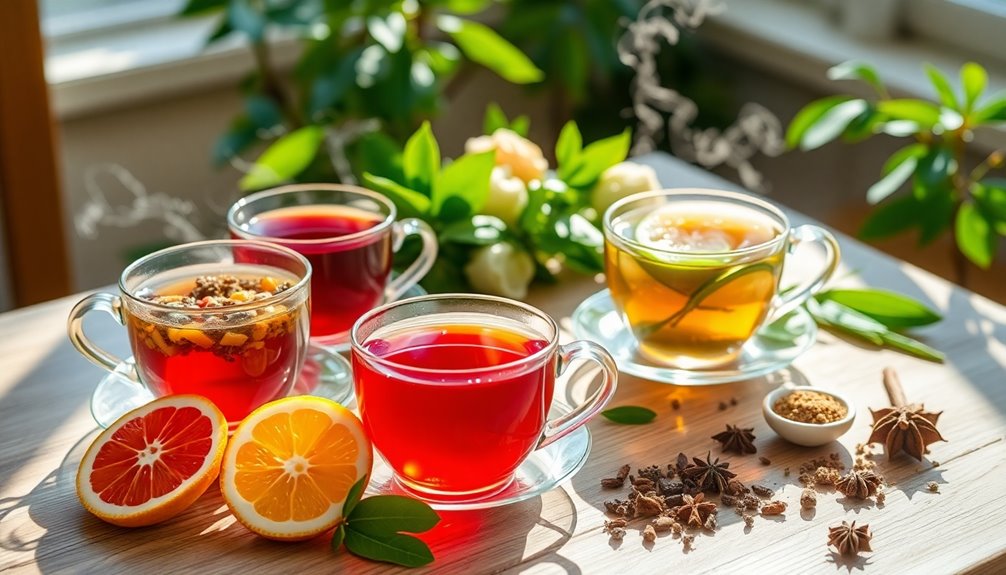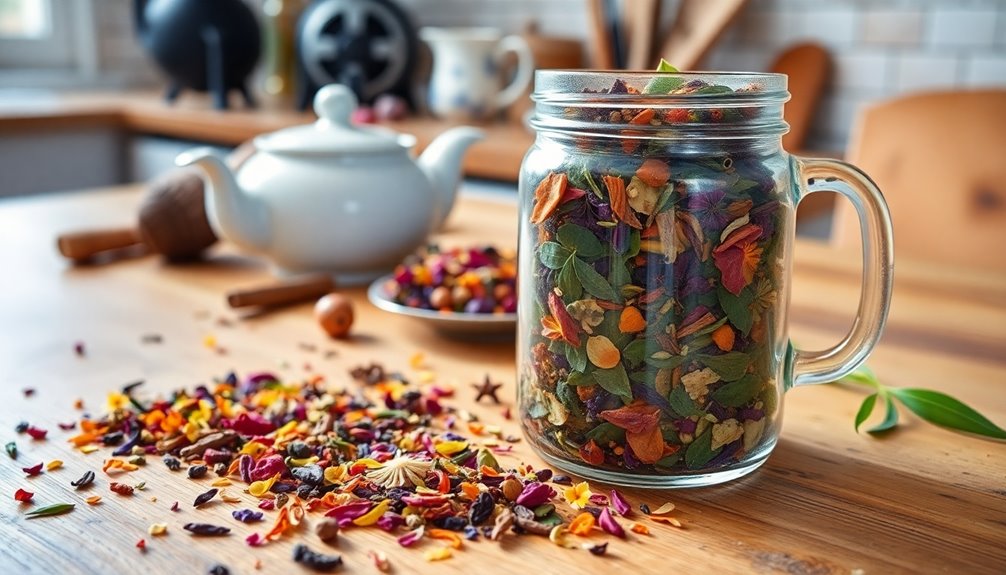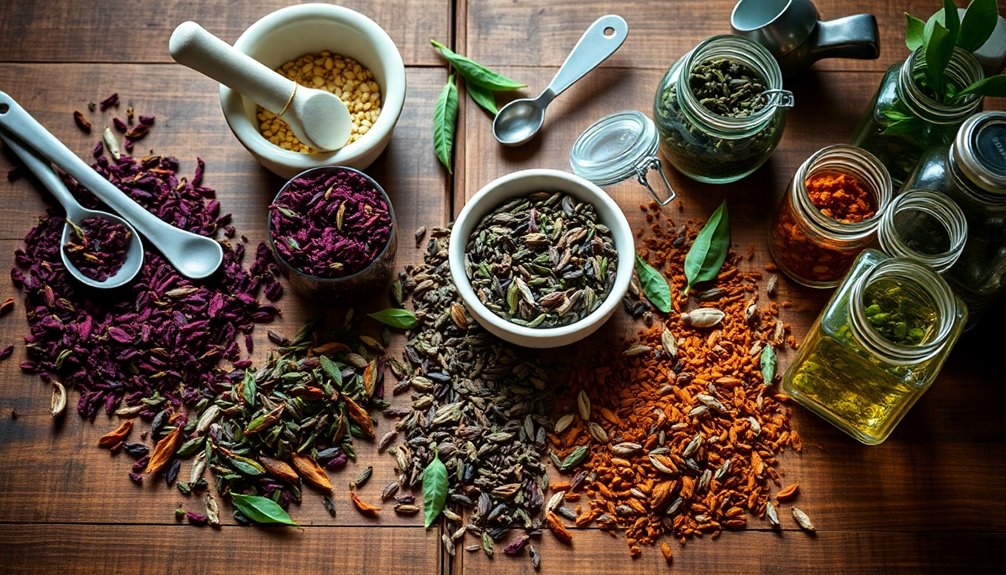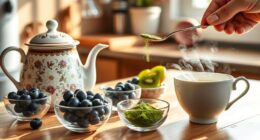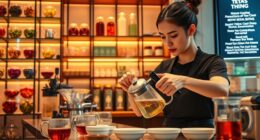Crafting your own herbal tea blends is a delightful adventure for all! Start by choosing a base herb, like chamomile or peppermint, that you love. Then, mix in supporting herbs or spices, such as ginger or cinnamon, to amp up the flavor and health benefits. Try a ratio of 3 parts base herb to 1-2 parts supporting herbs. Don't forget to steep your blend for 5 to 20 minutes to unlock its magic! Track your ratios for perfect repeats, and let your creativity flow. You'll discover endless possibilities by exploring all the delightful combinations waiting for you!
Key Takeaways
- Start by selecting a base herb that matches your flavor preference, such as chamomile or peppermint.
- Use the recommended ratio of 3 parts base herb to 1-2 parts supporting herbs for balanced flavor.
- Incorporate accent herbs or spices like ginger and cinnamon for added health benefits and complexity.
- Experiment with different steeping methods, including hot infusion and cold brewing, to find your ideal taste.
- Keep a record of your blends and their ratios to ensure reproducibility and refine your skills over time.
Introduction

Creating your own herbal tea blends can be a rewarding experience, allowing you to explore a world of flavors and health benefits. Imagine the joy of sipping a warm cup of tea that you crafted just for you!
Herbal tea blends are infusions made from a variety of plants like herbs, flowers, and spices. Each offers unique tastes and health benefits that can boost your well-being.
To get started with tea blending, think about the 3 Ps: Person, Plants, and Purpose. Consider who you're making the tea for, which different herbs you want to use, and what health benefits you hope to achieve. There's so much to explore!
Here are a few tips for creating your blends:
- Experiment: Don't be afraid to try new combinations.
- Track Ratios: Writing down how much of each herb you use helps you recreate your favorite blends.
- Adjust: If a blend tastes too strong or weak, tweak it until it's just right!
Herbal Tea Blend History
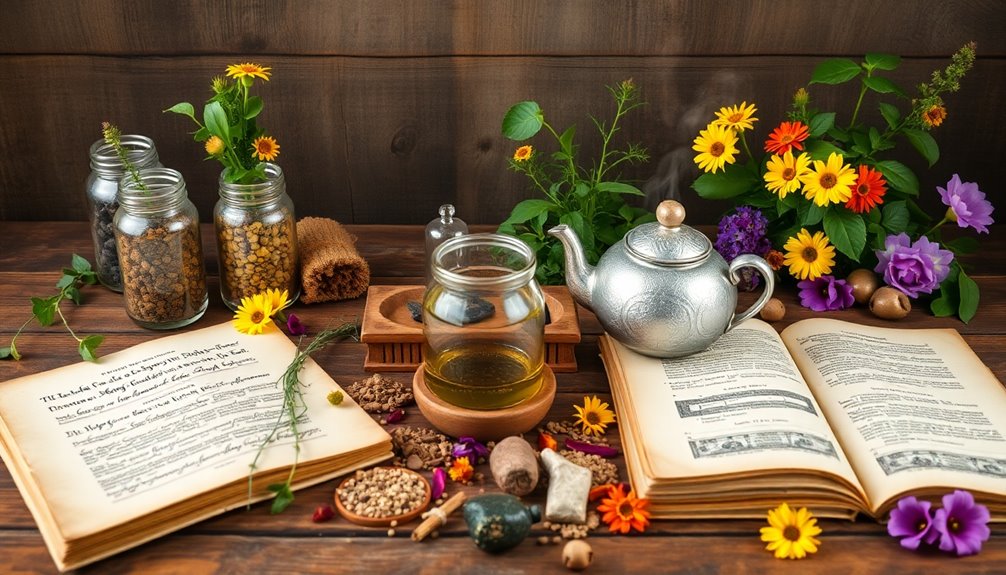
Herbal tea blends have a rich history that spans thousands of years, originating in ancient cultures like China, Egypt, and India. These cultures enjoyed herbal tea not just for its flavor but for its healing powers, making it a part of their daily lives and special rituals.
When making herbal tea, you might come across the term "tisane," which refers to a delightful infusion made from various plants, excluding the traditional tea plant. This means you can explore a wide range of herbs, flowers, and spices!
Different cultures have their own unique traditions around herbal tea. For example, the Japanese tea ceremony highlights mindfulness and beauty in both preparation and enjoyment.
Historical texts, like the ancient Chinese herbal medicine book "Shennong Bencao Jing," reveal the use of herbs for health benefits, paving the way for today's herbal blends.
In the 19th century, herbal teas gained popularity in the Western world. People began to embrace botanical remedies, and herbalists shared the exciting health benefits of diverse herbal blends.
Herbs Enhance Wellness and Flavor
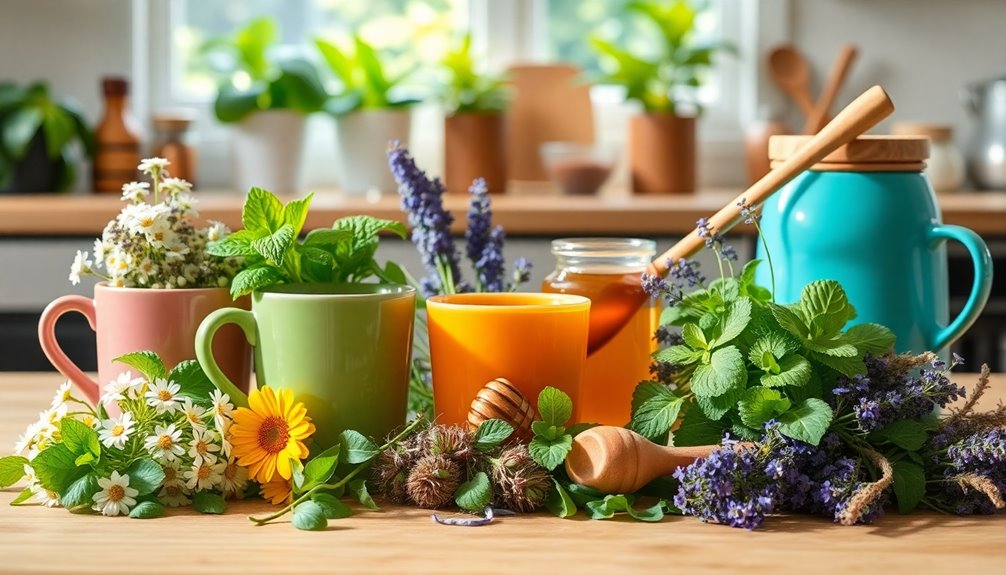
Many people turn to herbal teas not just for their soothing flavors, but also for the wellness benefits they offer. Imagine sipping on a warm cup of chamomile tea after a long day—it can help you relax and unwind! Herbal teas can also be enjoyed without the caffeine found in traditional teas, allowing for a calming experience at any time of day.
Different herbs can bring unique flavors and health perks to your tea leaves. For example, peppermint aids digestion, while echinacea gives your immune system a little boost. Additionally, including chia seeds can enhance the nutritional profile of your tea blend due to their high fiber content, which can aid in digestion and promote regularity. Drinking herbal teas like ginger may also provide anti-inflammatory properties that contribute to overall wellness.
When you create your own blends, think about using a mix of Herbs for Your Tea. A well-balanced blend usually includes a base herb, like chamomile, in larger amounts, plus a couple of supporting herbs and a hint of accent herbs for extra flavor. You could try adding ginger for a spicy kick and its anti-inflammatory properties, or turmeric to support digestion. Steeping your tea properly is key! Let your mixture steep for 5 to 20 minutes, depending on the herbs, to unlock those wonderful benefits. To enhance the flavor and therapeutic effects, consider using fresh or dried herbs, as the quality impacts flavor and health benefits.
Cultural Significance of Herbal Teas
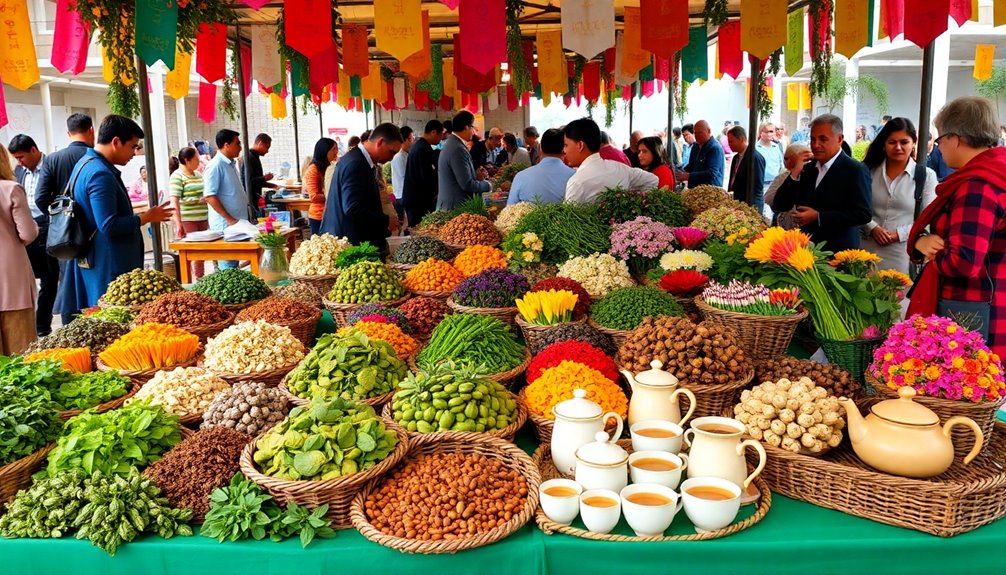
Why do herbal teas hold such a prominent place in cultures around the world? You'll find that herbal teas aren't just tasty beverages; they carry deep cultural significance and history. For centuries, people have used these medicinal brews to heal and connect.
- In ancient Egypt and China, herbal remedies were common, with herbal teas playing a vital role in health. Educational toys are also recognized for their importance in promoting well-being and learning in children.
- Traditional Chinese medicine even prescribes teas to help restore balance and harmony in the body.
- In India, chai isn't just a drink; it's a beloved ritual that brings people together during social gatherings, showcasing hospitality and connection.
Many Indigenous cultures also incorporate herbal teas into spiritual ceremonies, highlighting their respect for nature and the healing properties of plants. Additionally, certain herbal teas like chamomile and ginger have been traditionally used to alleviate discomfort, further emphasizing their medicinal importance across cultures.
The preparation and sharing of herbal teas often become community activities, strengthening bonds among friends and family.
Misleading Health Claims
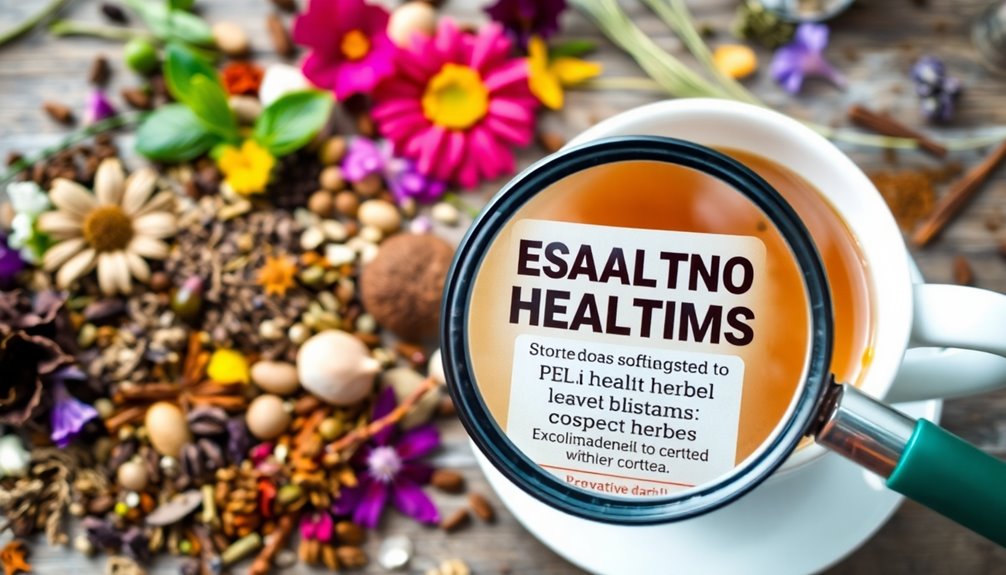
While the cultural significance of herbal teas is undeniable, it's important to approach their health claims with skepticism. Many of these claims come from stories instead of scientific research, making it easy to believe in benefits that may not be true.
For instance, you might see phrases like "cures all" or "miracle herb" on packaging. But remember, what works for one person may not work for another!
Here are a few points to keep in mind:
- FDA Regulation: Herbal teas aren't regulated as strictly as medicines, which can lead to exaggerated health claims. Additionally, the rapid advancements in data processing speeds may allow for better research on herbal remedies in the future.
- Specific Herbs: Some herbs might interact with medications or cause side effects. These risks are often hidden in marketing.
- Misinformation: Always consult reliable sources or healthcare professionals before using herbal teas for health conditions. Misinformation can lead to serious health issues. Additionally, understanding data privacy challenges is essential when using online sources to research herbal remedies, ensuring that your personal information remains protected.
Practical Applications
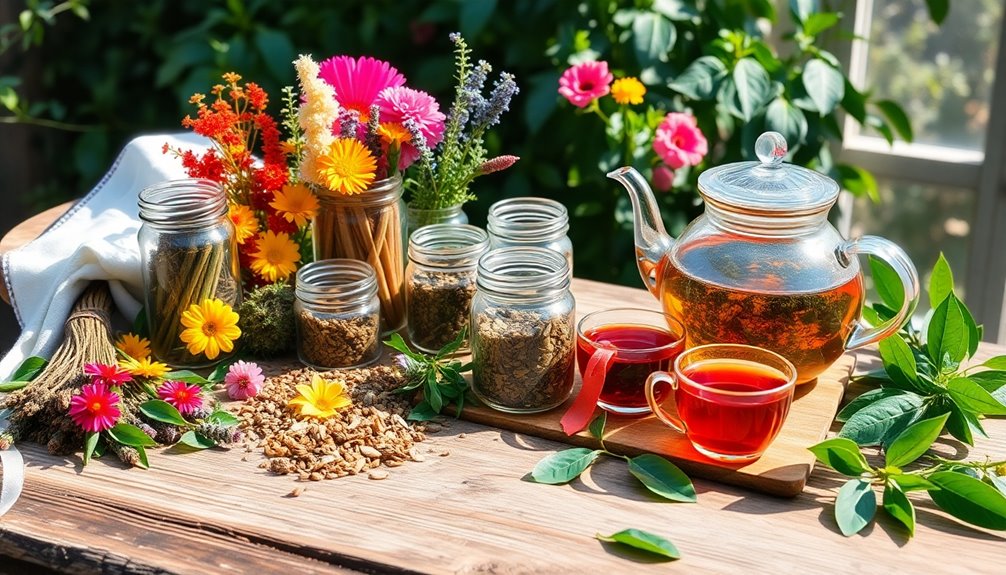
When you're ready to create your own herbal tea blends, start by choosing a base herb that matches your flavor preference. For example, you might pick chamomile for a relaxing cup of tea or peppermint for digestive support. Use a simple ratio of 3 parts base herb to 1-2 parts supporting herbs.
Next, think about adding some accent herbs or spices, like ginger or cinnamon, to boost both flavor and health benefits. It's fun to experiment! Try different steeping methods, like hot infusions for 15-20 minutes or cold brewing for 6-12 hours. Each method brings out unique flavors, making your herbal tea adventure even more exciting.
Don't forget to keep a record of your blends! Jot down the proportions and ingredients you used. This way, you can recreate your favorite blends and improve your skills over time.
Lastly, consider what you want your herbal tea to do. Are you looking for relaxation, immunity support, or a digestive aid? With a little creativity and experimentation, you'll be sipping delicious, healthful cups of tea in no time! Enjoy the journey!
Frequently Asked Questions
How to Create an Herbal Tea Blend?
To create an herbal tea blend, start by choosing a base herb that suits your taste. Mix in supporting and accent herbs, steep according to your preference, and adjust for flavor and health benefits. Enjoy experimenting!
What Teas Blend Well Together?
To create delightful tea blends, try pairing chamomile with lavender for relaxation, or peppermint with ginger for an invigorating kick. Hibiscus and rosehip offer a tart flavor, while echinacea and elderberry boost your immune system.
How Many Herbs Should Be in a Tea Blend?
You should aim for 3 to 5 herbs in your tea blend. This balance creates a harmonious flavor and maximizes health benefits, allowing you to explore unique combinations tailored to your taste preferences. Enjoy experimenting!
How Do I Start My Own Herbal Tea Business?
To start your own herbal tea business, research market trends, source quality herbs, create unique blends, and design attractive packaging. Promote your products through social media and local markets to engage customers and gather feedback.
Conclusion
Now that you know how to craft your own herbal tea blends, it's time to get creative! Gather your favorite herbs, mix them up, and enjoy the delightful flavors. Remember, each blend can boost your wellness and warm your heart. Invite family and friends to join the fun, and make it a tea party! So, grab your teapot, let the aromas fill the air, and celebrate the joy of herbal teas together. Happy brewing!


